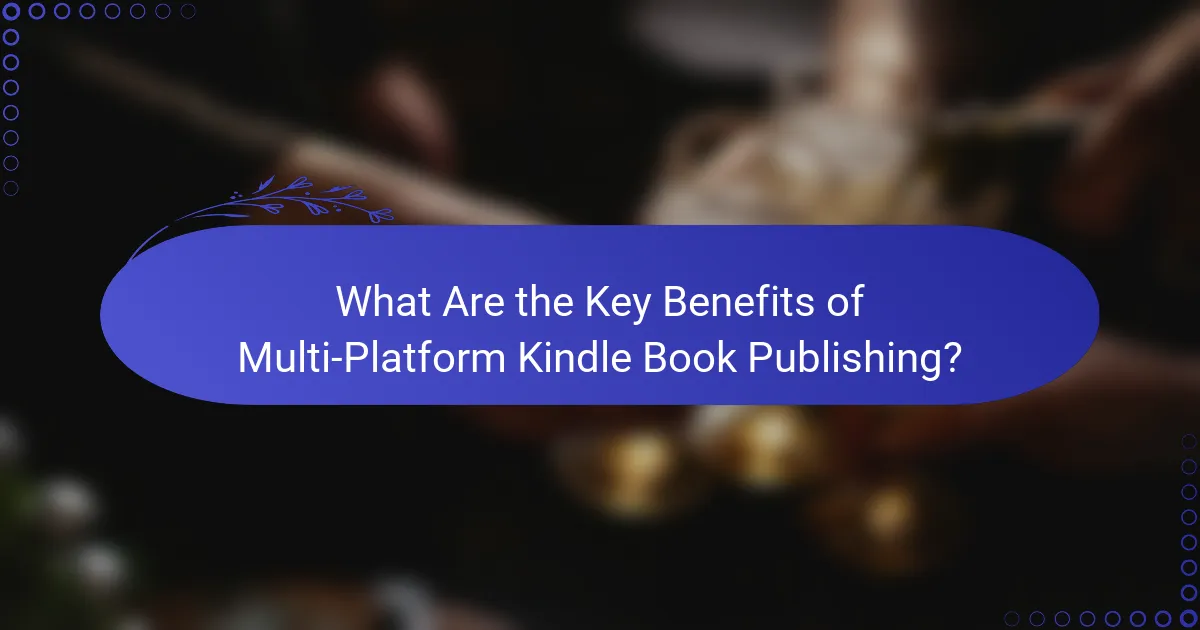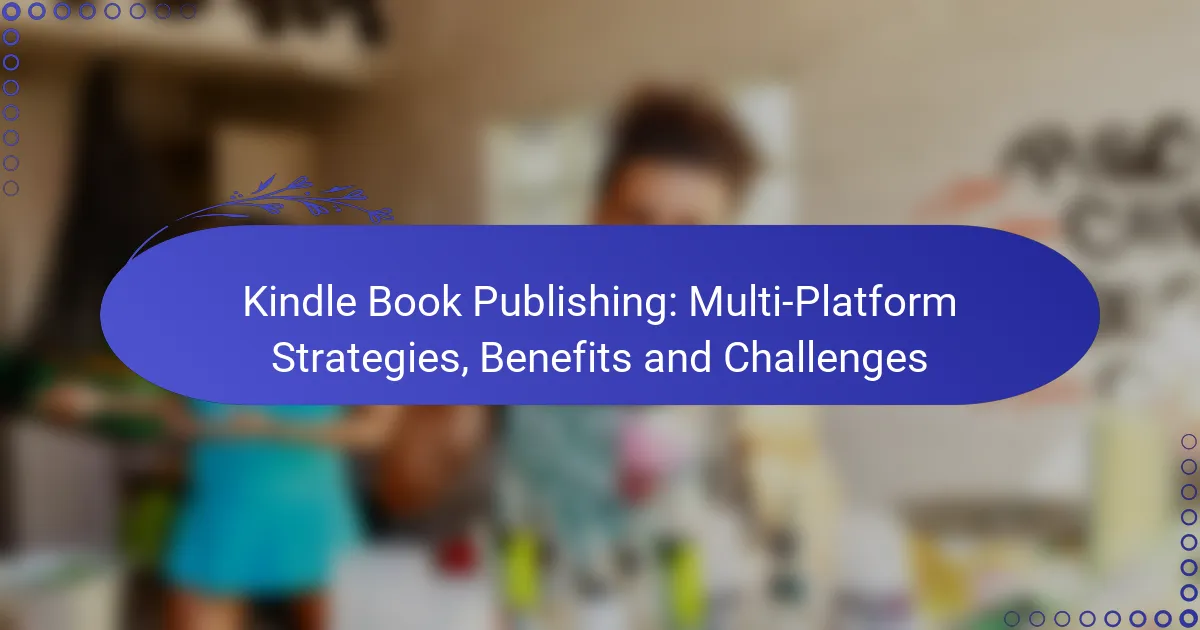Multi-platform Kindle book publishing offers authors the opportunity to expand their reach and increase revenue by tapping into diverse reader demographics. However, this approach comes with challenges, such as navigating different guidelines and managing marketing resources effectively. Choosing the right platforms is essential for optimizing both audience engagement and financial success.

What Are the Key Benefits of Multi-Platform Kindle Book Publishing?
Multi-platform Kindle book publishing allows authors to reach a broader audience and maximize their revenue potential. By distributing their work across various platforms, authors can tap into different reader demographics and preferences, enhancing their overall market presence.
Wider audience reach
Publishing on multiple platforms increases visibility, allowing authors to connect with diverse reader groups. Each platform attracts different audiences, so leveraging sites like Amazon, Apple Books, and Kobo can significantly expand your readership.
Consider targeting specific genres or niches that perform better on certain platforms. For example, romance novels often thrive on platforms with strong community features, while technical books may do better on sites focused on educational content.
Increased revenue streams
By utilizing various platforms, authors can create multiple income sources. Each platform has its own pricing structures and royalty rates, which can lead to higher overall earnings if managed effectively.
For instance, while Amazon may offer a 70% royalty on eBooks priced between $2.99 and $9.99, other platforms might have different rates. Authors should analyze these differences to optimize their pricing strategy across platforms.
Enhanced marketing opportunities
Multi-platform publishing opens up diverse marketing channels. Each platform may offer unique promotional tools, such as discounts, featured listings, or advertising options, which can help boost visibility and sales.
Utilizing social media and email marketing in conjunction with platform-specific promotions can create a synergistic effect, driving more traffic to your books. Engaging with readers through various channels can also build a loyal fan base.
Improved reader engagement
Engaging with readers across multiple platforms fosters a sense of community and loyalty. Authors can interact with their audience through reviews, comments, and social media, leading to deeper connections.
Consider hosting Q&A sessions or live readings on different platforms to enhance engagement. This personal touch can encourage readers to share your work and recommend it to others, further expanding your reach.
Access to diverse formats
Multi-platform publishing allows authors to offer their books in various formats, such as eBooks, audiobooks, and print. This flexibility caters to different reader preferences and can enhance sales potential.
For example, audiobooks are increasingly popular, and platforms like Audible provide opportunities for authors to reach listeners who prefer audio content. Offering multiple formats can significantly broaden your audience and increase overall sales.

What Challenges Do Authors Face in Multi-Platform Publishing?
Authors encounter several challenges when engaging in multi-platform publishing, including adhering to varying guidelines, managing revenue splits, and allocating marketing resources effectively. These obstacles can complicate the publishing process and impact overall success.
Platform-specific guidelines
Each publishing platform has its own set of guidelines that authors must follow, which can vary significantly. For instance, Amazon Kindle Direct Publishing (KDP) has specific formatting requirements and content restrictions that differ from those of Apple Books or Barnes & Noble Press. Authors need to familiarize themselves with these rules to avoid rejections and ensure their work is presented correctly.
To navigate these guidelines, authors should create a checklist for each platform, noting key requirements such as file formats, cover specifications, and content policies. This proactive approach can save time and reduce frustration during the publishing process.
Revenue sharing complexities
Revenue sharing models differ across platforms, which can lead to confusion regarding potential earnings. For example, KDP offers a 70% royalty rate for books priced between $2.99 and $9.99, while other platforms may have different structures that affect net income. Understanding these differences is crucial for authors aiming to maximize their profits.
Authors should analyze the revenue models of each platform they plan to use and calculate potential earnings based on their pricing strategy. This analysis can help in making informed decisions about where to publish and how to price their books.
Marketing resource allocation
Marketing a book across multiple platforms requires careful resource allocation to ensure visibility and sales. Authors must decide how much time and budget to dedicate to each platform, considering factors like audience reach and promotional tools available. For instance, social media advertising may work better on one platform than another.
To optimize marketing efforts, authors should develop a targeted marketing plan that includes specific strategies for each platform. This may involve using different promotional tactics, such as email campaigns, social media ads, or collaborations with influencers, tailored to the unique audience of each platform.
Formatting and compatibility issues
Formatting issues can arise when preparing a manuscript for multiple platforms, as each may require different file types and layouts. For example, a book formatted for KDP may not display correctly on Kobo or Google Play Books without adjustments. Authors must ensure that their files are compatible to avoid poor reader experiences.
Using professional formatting software or hiring a formatter can help streamline this process. Authors should also test their books on various devices and platforms before publication to identify and rectify any compatibility issues.
Time management
Managing time effectively is crucial when publishing on multiple platforms, as each step can be time-consuming. Authors need to balance writing, formatting, marketing, and monitoring sales across different platforms. This can lead to overwhelm if not managed properly.
To improve time management, authors should create a detailed schedule that allocates specific time blocks for each task related to their multi-platform publishing strategy. Setting realistic deadlines and prioritizing tasks can help maintain focus and ensure that all platforms receive adequate attention.

How to Choose the Right Platforms for Kindle Book Publishing?
Selecting the right platforms for Kindle book publishing is crucial for maximizing reach and revenue. Consider factors such as your target audience, platform features, royalty structures, and distribution capabilities to make an informed choice.
Assessing audience demographics
Understanding your audience demographics is essential when choosing a publishing platform. Analyze factors such as age, location, and reading preferences to identify where your potential readers are most active. For instance, younger audiences may prefer platforms with social features, while older readers might gravitate towards traditional eBook retailers.
Utilize tools like Google Analytics or social media insights to gather data on your audience. This information can guide you in selecting platforms that align with their habits and preferences.
Evaluating platform features
Each publishing platform offers unique features that can enhance your book’s visibility and sales. Consider aspects such as user interface, promotional tools, and compatibility with various devices. For example, platforms like Amazon Kindle Direct Publishing (KDP) provide extensive marketing options, while others may focus on niche markets.
Make a checklist of must-have features based on your publishing goals. This could include options for pricing control, promotional campaigns, or access to analytics for tracking sales performance.
Comparing royalty structures
Royalty structures vary significantly across publishing platforms, impacting your earnings. Most platforms offer royalties ranging from 35% to 70%, depending on factors like pricing and distribution choices. For example, KDP offers a 70% royalty option for books priced between $2.99 and $9.99.
Carefully review the terms and conditions of each platform to understand any additional fees or stipulations that may affect your overall earnings. This will help you choose a platform that maximizes your income potential.
Understanding distribution reach
The distribution reach of a platform determines how widely your book can be accessed. Some platforms, like KDP, provide global distribution, while others may focus on specific regions or countries. Assess whether your target audience is concentrated in certain areas and choose platforms that cater to those markets.
Consider using multiple platforms to enhance your distribution. This strategy can help you tap into various reader bases and increase your chances of sales across different regions. Just be mindful of any exclusivity agreements that may limit your options.

What Are Effective Marketing Strategies for Multi-Platform Publishing?
Effective marketing strategies for multi-platform publishing involve leveraging various channels to reach a wider audience. This includes utilizing social media, email campaigns, book promotion sites, and engaging with reader communities to maximize visibility and sales.
Utilizing social media
Social media platforms like Facebook, Twitter, and Instagram are powerful tools for promoting your book across multiple platforms. Create engaging content that resonates with your target audience, such as behind-the-scenes looks, quotes from your book, or interactive polls.
Consider using targeted ads to reach specific demographics, which can be particularly effective in driving traffic to your book’s sales page. Regularly interact with followers to build a loyal community and encourage word-of-mouth promotion.
Implementing email campaigns
Email marketing remains a highly effective strategy for reaching readers directly. Build an email list by offering a free chapter or exclusive content in exchange for sign-ups. Regular newsletters can keep your audience informed about new releases, promotions, and events.
Segment your email list to tailor messages based on reader preferences, which can increase engagement rates. Aim for a consistent schedule, whether weekly or monthly, to maintain visibility without overwhelming your subscribers.
Leveraging book promotion sites
Book promotion sites can significantly boost your book’s visibility, especially during launch periods. Consider submitting your book to platforms like BookBub or Freebooksy, which can help you reach thousands of potential readers.
Evaluate the costs and benefits of each site, as some may require a fee while others offer free listings. Monitor the performance of your promotions to identify which sites yield the best return on investment.
Engaging with reader communities
Participating in reader communities, such as Goodreads or specific Facebook groups, allows you to connect with potential fans. Share insights about your writing process, participate in discussions, and offer giveaways to create interest in your work.
Be genuine in your interactions; avoid overt self-promotion, as this can alienate potential readers. Instead, focus on building relationships and providing value to the community, which can lead to organic support for your books.
